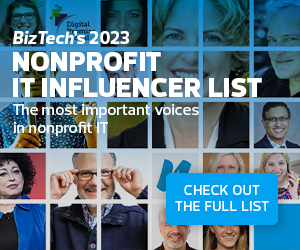In the 11 years since the first GivingTuesday in 2012, the movement has become a wellspring of generosity: Donors gave $3.1 billion in 2022’s event. As if that weren’t staggering on its own, that $3.1 billion represents a 15 increase from 2021, and the number of people who contributed rose 6 percent in that same period.
A GivingTuesday campaign can spur donations that might not come in otherwise, as 86 percent of people surveyed say that GivingTuesday inspired them to be more generous — including 93 percent of donors ages 18 to 34, suggesting that the future of GivingTuesday shines bright.
Nonprofit tech leaders play a critical role in driving the success of GivingTuesday. Infrastructure is important, of course, but it’s data that gets a star turn in maximizing the day. Here are five ways data can improve a nonprofit’s GivingTuesday.
Click the banner to checkout our list of 30 nonprofit IT professionals worth a follow.
The Importance of Segmenting Your Data and Personalizing Outreach
Data helps nonprofits understand their donor base — or rather, their donor bases: Data reveals differences among groups of donors, such as donation history, demographics, engagement patterns, instead of treating donors as a monolith. With this information, nonprofits can craft customized messages for various donor audiences to better match their motivations for giving.
When the American Lung Association looked at its disengaged donors, it discovered differences among audiences. It found four primary motivations for donating: advocacy, clean air, lung health and smoking cessation. From there, the organization was able to shape messaging to better target disengaged donors. The result: Its donor roster grew by 50 percent over two years.
DISCOVER: Find out how these CDW nonprofit services can help you fulfill your mission.
Predictive Analytics Can Help Nonprofits Plan for the Future
GivingTuesday is a bare-bones example of predictive analytics: Based on the history of GivingTuesday, organizations can anticipate an influx of donations on that day. Now, imagine if nonprofits could have that insight into more complex future donation patterns, or even the identity of future donors.
Predictive analytics models can help nonprofits do exactly that. By scrutinizing data-driven ROI of past campaigns and projecting that onto future programs, nonprofit leaders get a peek into what to expect. They can then tailor campaigns to invest their resources in the programs with the highest returns and toward donors who are likeliest to maximize their giving potential.
86%
The percentage of people who say GivingTuesday inspired them to be more generous
Source: GivingTuesday.com Survey, “Why should you reach out to your donors on GivingTuesday?,” Oct. 2023
Keep Operations Efficient and Make the Most of Limited Resources
Turning to data can help nonprofits make the most of their limited resources by giving hard evidence of what’s working and what’s not. This can help guide leaders who face tough decisions — say, dropping or modifying a legacy project that’s been underperforming. In turn, more of the organization’s resources can go toward programming instead of overhead.
Sometimes data is the operational efficiency. When childhood hunger nonprofit Share Our Strength turned to a data lake, it uncovered hidden efficiencies thanks to having data consolidated in one place.
RELATED: Read about these advanced digital fundraising tactics for nonprofits.
Measuring Impact and Sharing That Transparently With Donors
Just as data enables evidence-based decision-making for nonprofit leaders, it does the same for donors. Using data to drive the narrative of a nonprofit’s success in fulfilling its mission demonstrates to donors in concrete terms that their funds are making a measurable difference for the beneficiaries.
This transparency comes in handy for accountability checks as well, supporting nonprofits in reporting to the IRS and to their boards how funds are being used.
EXPLORE: Learn how one nonprofit turned to the cloud for data-driven solutions.
Emphasize Real-Time Monitoring and Response Metrics
Data can be used to engage donors in real time to make sure the message of GivingTuesday is penetrating. From there, data can also help leaders adjust marketing strategies on the fly; for example, if engagement seems particularly strong on one channel and weak on another, a social media manager can focus on the platform of choice.
And if any technical issues arise on the big day, data can be an early indicator of problems and can help IT leaders address them quickly, helping GivingTuesday live up to its promise of real impact for nonprofits.











